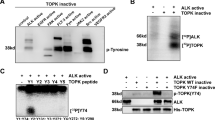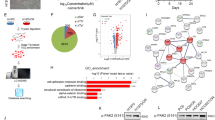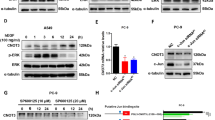Abstract
Paxillin (PXN) is required for receptor tyrosine kinase-mediated ERK activation, and the activation of the Raf/MEK/ERK cascade has been linked with Bcl-2 expression. We hypothesized that phosphorylation of PXN by the EGFR/Src pathway might contribute to cisplatin resistance via increased Bcl-2 expression. We show that cisplatin resistance was dependent on PXN expression, as evidenced by PXN overexpression in TL-13 and TL-10 cells and PXN knockdown in H23 and CL1-5 cells. Specific inhibitors of signaling pathways indicated that the phosphorylation of PXN at Y118 and Y31 via the Src pathway was responsible for cisplatin resistance. We further demonstrated that ERK activation was also dependent on this PXN phosphorylation. Bcl-2 transcription was upregulated by phosphorylated PXN-mediated ERK activation via increased binding of phosphorylated CREB to the Bcl-2 promoter. A subsequent increase in Bcl-2 levels by a PXN/ERK axis was responsible for the resistance to cisplatin. Animal models further confirmed the findings of in vitro cells indicating that xenograft tumors induced by TL-13-overexpressing cells were successfully suppressed by cisplatin combined with Src or ERK inhibitor compared with treatment of cisplatin, Src inhibitor or ERK inhibitor alone. A positive correlation of phosphorylated PXN with phosphorylated ERK and Bcl-2 was observed in lung tumors from NSCLC patients. Patients with tumors positive for PXN, phosphorylated PXN, phosphorylated ERK and Bcl-2 more commonly showed a poorer response to cisplatin-based chemotherapy than did patients with negative tumors. Collectively, PXN phosphorylation might contribute to cisplatin resistance via activating ERK-mediated Bcl-2 transcription. Therefore, we suggest that Src or ERK inhibitor might be helpful to improve the sensitivity for cisplatin-based chemotherapy in NSCLC patients with PXN-positive tumors.
This is a preview of subscription content, access via your institution
Access options
Subscribe to this journal
Receive 50 print issues and online access
$259.00 per year
only $5.18 per issue
Buy this article
- Purchase on Springer Link
- Instant access to full article PDF
Prices may be subject to local taxes which are calculated during checkout






Similar content being viewed by others
References
Aponte M, Jiang W, Lakkis M, Li MJ, Edwards D, Albitar L et al. Activation of platelet-activating factor receptor and pleiotropic effects on tyrosine phospho-EGFR/Src/FAK/paxillin in ovarian cancer. Cancer Res 2008; 68: 5839–5848.
Sachdev S, Bu Y, Gelman IH . Paxillin-Y118 phosphorylation contributes to the control of Src-induced anchorage-independent growth by FAK and adhesion. BMC Cancer 2009; 9: 12.
Webb DJ, Donais K, Whitmore LA, Thomas SM, Turner CE, Parsons JT et al. FAK-Src signalling through paxillin, ERK and MLCK regulates adhesion disassembly. Nat Cell Biol 2004; 6: 154–161.
Deakin NO, Turner CE . Paxillin comes of age. J Cell Sci 2008; 121: 2435–2444.
Huang C, Rajfur Z, Borchers C, Schaller MD, Jacobson K . JNK phosphorylates paxillin and regulates cell migration. Nature 2003; 424: 219–223.
Wu DW, Cheng YW, Wang J, Chen CY, Lee H . Paxillin predicts survival and relapse in non-small cell lung cancer by microRNA-218 targeting. Cancer Res 2010; 70: 10392–10401.
Shintani Y, Okimura A, Sato K, Nakagiri T, Kadota Y, Inoue M et al. Epithelial to mesenchymal transition is a determinant of sensitivity to chemoradiotherapy in non-small cell lung cancer. Ann Thorac Surg 2011; 92: 1794–1804 (discussion 1804).
Zhuo WL, Wang Y, Zhuo XL, Zhang YS, Chen ZT . Short interfering RNA directed against TWIST, a novel zinc finger transcription factor, increases A549 cell sensitivity to cisplatin via MAPK/mitochondrial pathway. Biochem Biophys Res Commun 2008; 369: 1098–1102.
Haslehurst AM, Koti M, Dharsee M, Nuin P, Evans K, Geraci J et al. EMT transcription factors snail and slug directly contribute to cisplatin resistance in ovarian cancer. BMC Cancer 2012; 12: 91.
Ishibe S, Joly D, Zhu X, Cantley LG . Phosphorylation-dependent paxillin-ERK association mediates hepatocyte growth factor-stimulated epithelial morphogenesis. Mol Cell 2003; 12: 1275–1285.
Sen A, De Castro I, Defranco DB, Deng FM, Melamed J, Kapur P et al. Paxillin mediates extranuclear and intranuclear signaling in prostate cancer proliferation. J Clin Invest 2012; 122: 2469–2481.
Sen A, O’Malley K, Wang Z, Raj GV, Defranco DB, Hammes SR . Paxillin regulates androgen- and epidermal growth factor-induced MAPK signaling and cell proliferation in prostate cancer cells. J Biol Chem 2010; 285: 28787–28795.
Arany I, Megyesi JK, Reusch JE, Safirstein RL . CREB mediates ERK-induced survival of mouse renal tubular cells after oxidant stress. Kidney Int 2005; 68: 1573–1582.
Boucher MJ, Morisset J, Vachon PH, Reed JC, Laine J, Rivard N . MEK/ERK signaling pathway regulates the expression of Bcl-2, Bcl-X(L), and Mcl-1 and promotes survival of human pancreatic cancer cells. J Cell Biochem 2000; 79: 355–369.
Creson TK, Yuan P, Manji HK, Chen G . Evidence for involvement of ERK, PI3K, and RSK in induction of Bcl-2 by valproate. J Mol Neurosci 2009; 37: 123–134.
Subramanian M, Shaha C . Up-regulation of Bcl-2 through ERK phosphorylation is associated with human macrophage survival in an estrogen microenvironment. J Immunol 2007; 179: 2330–2338.
Wang J, Zhou JY, Wu GS . ERK-dependent MKP-1-mediated cisplatin resistance in human ovarian cancer cells. Cancer Res 2007; 67: 11933–11941.
Yoon H, Min JK, Lee JW, Kim DG, Hong HJ . Acquisition of chemoresistance in intrahepatic cholangiocarcinoma cells by activation of AKT and extracellular signal-regulated kinase (ERK)1/2. Biochem Biophys Res Commun 2011; 405: 333–337.
Jagadeeswaran R, Surawska H, Krishnaswamy S, Janamanchi V, Mackinnon AC, Seiwert TY et al. Paxillin is a target for somatic mutations in lung cancer: implications for cell growth and invasion. Cancer Res 2008; 68: 132–142.
Sheibani N, Tang Y, Sorenson CM . Paxillin’s LD4 motif interacts with bcl-2. J Cell Physiol 2008; 214: 655–661.
Sorenson CM . Interaction of bcl-2 with Paxillin through its BH4 domain is important during ureteric bud branching. J Biol Chem 2004; 279: 11368–11374.
Tabassam FH, Graham DY, Yamaoka Y . Paxillin is a novel cellular target for converging Helicobacter pylori-induced cellular signaling. Am J Physiol Gastrointest Liver Physiol 2011; 301: G601–G611.
Zou W, Deselm CJ, Broekelmann TJ, Mecham RP, Vande Pol S, Choi K et al. Paxillin contracts the osteoclast cytoskeleton. J Bone Miner Res 2012; 27: 2490–2500.
Turner CE . Paxillin interactions. J Cell Sci 2000; 113 (Pt 23): 4139–4140.
Johnson FM, Saigal B, Talpaz M, Donato NJ . Dasatinib (BMS-354825) tyrosine kinase inhibitor suppresses invasion and induces cell cycle arrest and apoptosis of head and neck squamous cell carcinoma and non-small cell lung cancer cells. Clin Cancer Res 2005; 11: 6924–6932.
Bai L, Yang JC, Ok JH, Mack PC, Kung HJ, Evans CP . Simultaneous targeting of Src kinase and receptor tyrosine kinase results in synergistic inhibition of renal cell carcinoma proliferation and migration. Int J Cancer 2012; 130: 2693–2702.
Meller R, Minami M, Cameron JA, Impey S, Chen D, Lan JQ et al. CREB-mediated Bcl-2 protein expression after ischemic preconditioning. J Cereb Blood Flow Metab 2005; 25: 234–246.
Hiscox S, Morgan L, Green TP, Barrow D, Gee J, Nicholson RI . Elevated Src activity promotes cellular invasion and motility in tamoxifen resistant breast cancer cells. Breast Cancer Res Treat 2006; 97: 263–274.
Sakata H, Takayama H, Sharp R, Rubin JS, Merlino G, LaRochelle WJ . Hepatocyte growth factor/scatter factor overexpression induces growth, abnormal development, and tumor formation in transgenic mouse livers. Cell Growth Differ 1996; 7: 1513–1523.
Bertotti A, Bracco C, Girolami F, Torti D, Gastaldi S, Galimi F et al. Inhibition of Src impairs the growth of met-addicted gastric tumors. Clin Cancer Res 2010; 16: 3933–3943.
Nayal A, Webb DJ, Brown CM, Schaefer EM, Vicente-Manzanares M, Horwitz AR . Paxillin phosphorylation at Ser273 localizes a GIT1-PIX-PAK complex and regulates adhesion and protrusion dynamics. J Cell Biol 2006; 173: 587–589.
Lee JH, Wittki S, Brau T, Dreyer FS, Kratzel K, Dindorf J et al. HIV Nef, paxillin, and Pak1/2 regulate activation and secretion of TACE/ADAM10 proteases. Mol Cell 2013; 49: 668–679.
Yang TM, Barbone D, Fennell DA, Broaddus VC . Bcl-2 family proteins contribute to apoptotic resistance in lung cancer multicellular spheroids. Am J Respir Cell Mol Biol 2009; 41: 14–23.
Li J, Viallet J, Haura EB . A small molecule pan-Bcl-2 family inhibitor, GX15-070, induces apoptosis and enhances cisplatin-induced apoptosis in non-small cell lung cancer cells. Cancer Chemother Pharmacol 2008; 61: 525–534.
Mano Y, Kikuchi Y, Yamamoto K, Kita T, Hirata J, Tode T et al. Bcl-2 as a predictor of chemosensitivity and prognosis in primary epithelial ovarian cancer. Eur J Cancer 1999; 35: 1214–1219.
Miyake H, Hanada N, Nakamura H, Kagawa S, Fujiwara T, Hara I et al. Overexpression of Bcl-2 in bladder cancer cells inhibits apoptosis induced by cisplatin and adenoviral-mediated p53 gene transfer. Oncogene 1998; 16: 933–943.
Bendardaf R, Lamlum H, Ristamaki R, Syrjanen K, Pyrhonen S . Oncoprotein Bcl-2 and microsatellite instability are associated with disease-free survival and treatment response in colorectal cancer. Oncol Rep 2008; 20: 999–1004.
Bray K, Chen HY, Karp CM, May M, Ganesan S, Karantza-Wadsworth V et al. Bcl-2 modulation to activate apoptosis in prostate cancer. Mol Cancer Res 2009; 7: 1487–1496.
Low SY, Tan BS, Choo HL, Tiong KH, Khoo AS, Leong CO . Suppression of BCL-2 synergizes cisplatin sensitivity in nasopharyngeal carcinoma cells. Cancer Lett 2012; 314: 166–175.
Sung WW, Wang YC, Cheng YW, Lee MC, Yeh KT, Wang L et al. A polymorphic -844T/C in FasL promoter predicts survival and relapse in non-small cell lung cancer. Clin Cancer Res 2011; 17: 5991–5999.
Wu DW, Tsai LH, Chen PM, Lee MC, Wang L, Chen CY et al. Loss of TIMP-3 promotes tumor invasion via elevated IL-6 production and predicts poor survival and relapse in HPV-infected non-small cell lung cancer. Am J Pathol 2012; 181: 1796–1806.
Wu D-W, Lee M-C, Wang J, Chen C-Y, Cheng Y-W, Lee H . DDX3 loss by p53 inactivation promotes tumor malignancy via the MDM2/Slug/E-cadherin pathway and poor patient outcome in non-small-cell lung cancer. Oncogene 2014; 33: 1515–1526.
Wu DW, Liu WS, Wang J, Chen CY, Cheng YW, Lee H . Reduced p21(WAF1/CIP1) via alteration of p53-DDX3 pathway is associated with poor relapse-free survival in early-stage human papillomavirus-associated lung cancer. Clin Cancer Res 2011; 17: 1895–1905.
Acknowledgements
This work was jointly supported by grants from the National Health Research Institute (NHRI96-TD-G-111-006; NHRI97-TD-G-111-006) and the National Science Council (NSC-100-2314-B-038-043-MY3) of Taiwan, ROC.
Author information
Authors and Affiliations
Corresponding author
Ethics declarations
Competing interests
The authors declare no conflict of interest.
Additional information
Supplementary Information accompanies this paper on the Oncogene website
Supplementary information
Rights and permissions
About this article
Cite this article
Wu, DW., Wu, TC., Wu, JY. et al. Phosphorylation of paxillin confers cisplatin resistance in non-small cell lung cancer via activating ERK-mediated Bcl-2 expression. Oncogene 33, 4385–4395 (2014). https://doi.org/10.1038/onc.2013.389
Received:
Revised:
Accepted:
Published:
Issue Date:
DOI: https://doi.org/10.1038/onc.2013.389
Keywords
This article is cited by
-
Cisplatin-induced increase in heregulin 1 and its attenuation by the monoclonal ErbB3 antibody seribantumab in bladder cancer
Scientific Reports (2023)
-
SNRPB is a mediator for cellular response to cisplatin in non-small-cell lung cancer
Medical Oncology (2021)
-
Letrozole improves the sensitivity of breast cancer cells overexpressing aromatase to cisplatin via down-regulation of FEN1
Clinical and Translational Oncology (2019)
-
DDX3 promotes tumor invasion in colorectal cancer via the CK1ε/Dvl2 axis
Scientific Reports (2016)
-
TC-N19, a novel dual inhibitor of EGFR and cMET, efficiently overcomes EGFR-TKI resistance in non-small-cell lung cancer cells
Cell Death & Disease (2016)



